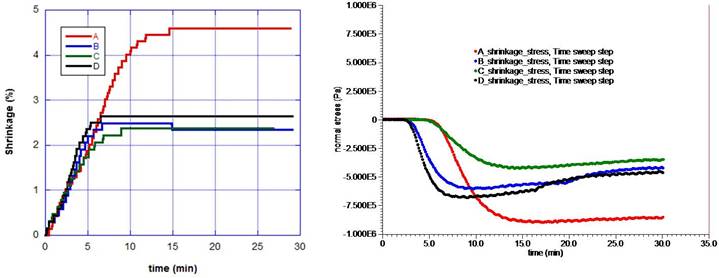Friday, March 23, 2012: 3:30 p.m. - 4:45 p.m.
Presentation Type: Poster Discussion Session
D. SHIN, and B. SUH, BISCO, Inc, Schaumburg, IL
Objectives:
The aim of this study was to demonstrate a simple and quick rheology-based
test method to characterize polymerization shrinkage and contraction stress
during setting of self-cured restorative materials utilizing normal force and
gap control capabilities of a modern rheometer.
Methods: For
both shrinkage and contraction stress measurement, time sweeps were conducted with 1 Hz
frequency using 8 mm diameter parallel plates with 0.7 mm gap at 23 ēC. In polymerization shrinkage measurement, constant
compressive normal force of 0.2 N was applied and gap changes were monitored to
measure linear polymerization shrinkage. Gap at cross-over point of G′ and
G″, which is considered to be starting point of gelation,
was compared with subsequently monitored gap changes. For contraction stress measurement, gap
between two parallel plates was set to fixed value (0.7 mm) and stress build-up
due to polymerization shrinkage was monitored using a built-in normal force transducer.
0.05% oscillation shear strain was
applied in both experiments to minimize disruption of polymerization process and all experiments were conducted while
avoiding ambient light. Tested materials in this study were
experimental dual-cured luting cement (A), dual-cured
core material (B), self-cured cement (C), and self-cured composite (D).
Results: Calculated
shrinkage percentages based on linear shrinkage measurements in this study were
well agreed with volumetric shrinkage percentages measured using video
imaging-based AcuVol.
For all test specimens, shrinkage contraction stress was increased
rapidly right after G′ and G″ cross-over point and decreased
slightly after maximum possibly due to material relaxation. Experimental dual-cured cement produced highest shrinkage and contraction stress
as expected. Lowest contraction stress
was observed in self-cured composite originally developed for reducing
polymerization shrinkage stress.
Conclusion: In
this study, polymerization shrinkage and shrinkage stress were measured in same
experimental configuration so that relationship between shrinkage strain and
stress can be correlated more directly.

Keywords: Cements, Composites, Dental materials, Polymerization and Stress
![[ Visit AADR's Website ]](images/banner.jpg)
